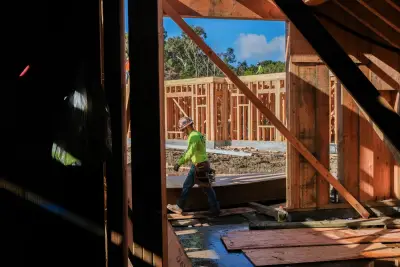Walters: California’s pro-housing laws have failed to raise new home numbers

California YIMBY an organization founded eight years ago to promote housing construction in response to an ever-increasing gap between demand and supply held a achievement party in San Francisco just now Welcome to the greater part victorious of California YIMBY s preeminence parties Brian Hanlon founder and CEO of the organization stated attendees Its acronym Yes In My Backyard symbolizes its years-long battle with NIMBYs Not in My Backyard people and groups who have long thwarted housing projects by pressuring local governments that control land use Related Articles Bishop Ranch in San Ramon leads Bay Area return to office pace Antioch council approves housing projects by developer involved in alleged corruption scheme Assisted living senior care site in Los Gatos lands buyer from Chicago Los Gatos Planning Commission approves cost-saving concessions on North Shift surfaces for San Jose housing project with -plus homes YIMBY s party marked the passage of several pro-housing legislative measures this year two of which have long been sought by housing advocates Assembly Bill exempts a large number of urban housing projects from the California Environmental Quality Act while Senate Bill makes it easier to building high-density housing near transit stations in large cities was a year Hanlon gleefully declared The celebratory atmosphere was understandable because this year s legislative actions capped a half-decade of ever-mounting state regime activism on housing that followed Gov Gavin Newsom s campaign pledge to build million new units of housing if elected That goal was wildly unrealistic as Newsom should have known but he did push hard for act to remove obstacles to housing rise His housing agency also ramped up pressure on local governments to remove arbitrary hurdles that YIMBY-influenced representatives had erected and to meet quotas for identifying land that could be used for housing However the celebration omitted one salient factor Pro-housing legislative and administrative actions have failed to markedly increase housing production New housing starts were around a year when Newsom took office in and they are about that number in contemporary times with the net increase even lower As the Housing and Public Evolution Department admits in its statewide housing plan Not enough housing being built During the last ten years housing production averaged fewer than new homes each year and ongoing production continues to fall far below the projected need of additional homes annually The Census Bureau calculates that since Newsom took office new housing permits in California ranged from a high of units in to a low of last year Newsom s own budget agrees with the Census Bureau s evidence for the same period and projects future construction through at to units a year Those are the numbers But how records on housing is collected and collated has been a somewhat murky process and opponents of housing projects often challenge how they comport with quotas the state imposes on local communities Fortunately the Census Bureau has unveiled a new statistical tool that should go a long way toward having complete material that includes not only conventional single- and multi-family projects but alternative forms of housing such as backyard granny flats officially known as Accessory Dwelling Units basements or garages that are transformed into apartments single-family homes converted into duplexes or apartments mobile homes or office buildings that become housing The tool uses several sources of material but is heavily reliant on the Postal Facility which maintains a constantly updated roster of addresses that includes all housing types More accurate evidence should make it easier to overcome conflicts and may even reveal that California s pro-housing actions have had positive effects that current methodology misses The housing problem has persisted in part because we haven t been able to measure our progress accurately an article about the new tool published by the Niskanen Center a think tank concludes With the Census Bureau s Address Count Listing File details that excuse is gone Now the question is whether policymakers will use this powerful new tool to completely build the housing America requirements Dan Walters is a CalMatters columnist


